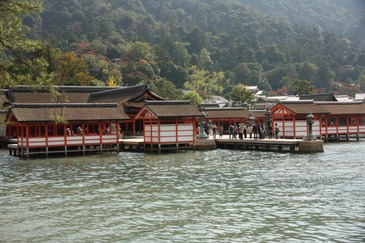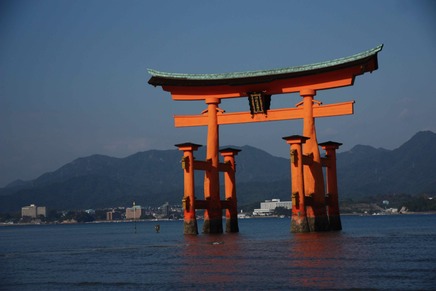
Miyajima means shrine-island in Japanese, a direct reference to Itsukushima Shrine, a UNESCO World Heritage Site, and the image most commonly associated with the island is the shrine’s floating torii gate set in the Seto Inland Sea.
The red-lacquered complex of halls and pathways that comprise the shrine and its torii gate are built over water and seem to float in the sea at high tide. The shrine’s buildings, including the prayer hall, main hall and a noh theatre are connected by boardwalks supported by stilts, built so commoners could visit without defiling the ground by walking on it. Retaining the purity of the shrine is important and since 1878 there have been no deaths or births near the shrine. Pregnant women are supposed to head to the mainland as their time approaches, as are terminally ill or the very elderly. Burials are still forbidden.
The shrine’s structure is based on the idea that the island itself is sacred, so, in the days before mass tourism, commoners approached the shrine by water, steering their boats through the torii before approaching the shrine, built so it existed on the threshold between the sacred and the profane. Away from the shrine and its boardwalks nowadays paths take visitors around the inlet to the other shrines and temples on the island, and to the island's highest peak, Mount Misen, which has been worshiped by local people since the sixth century. The buildings have been destroyed and rebuilt many times, and the current design dates back to 1168, when Taira no Kiyomori, the most powerful man in Japan at the end of the Heian Period, selected the island as the site for his clan's family shrine.

That was the origin of Itsukushima and though the present shrine dates from the middle of the sixteenth century it follows the earlier twelfth century design. Near the main shrine a Noh theatre stage, built by Toyotomi Hideyoshi in the late sixteenth century, is used to honour to the gods, and act out key events in the mythic history of Shinto.
The torii and the view of the gate in front of Itsukushima Shrine with Mount Misen in the background is one of the Three Views of Japan (along with the sand bar Amanohashidate, in Miyazu Bay in northern Kyoto Prefecture and Matsushima near Sendai). There has been a gate in place since the twelfth century, but the current sixteen metre high gate, which dates back to 1875 is built from decay-resistant camphor wood with an extra leg before and behind each main pillar reflecting the style of Ryōbu Shintō, a school of esoteric Japanese Buddhism associated with the Shingon Sect.
Though the shrine and its torii float above the water at high tide, when the tide falls and the water drains out of the bay the torii can be approached on foot and visitors take the opportunity to walk out, view the gate from close quarters, place coins in the cracks of the legs, make a wish and gather shellfish to add to their miso soup.
That, more than likely, was what had been happening as our boat approached, but given the sheer weight of numbers in the era of mass tourism you'd figure shellfish would be few and far between these days.